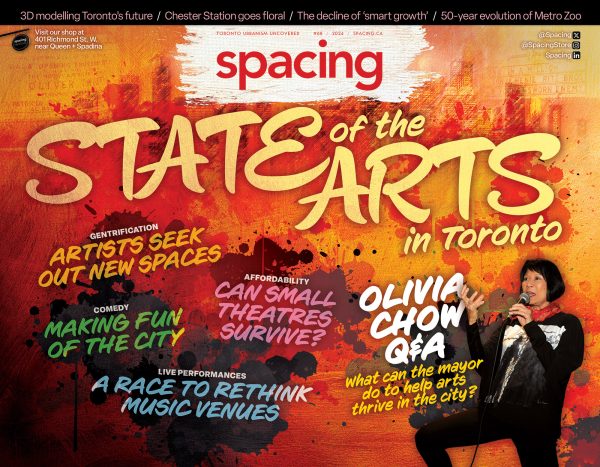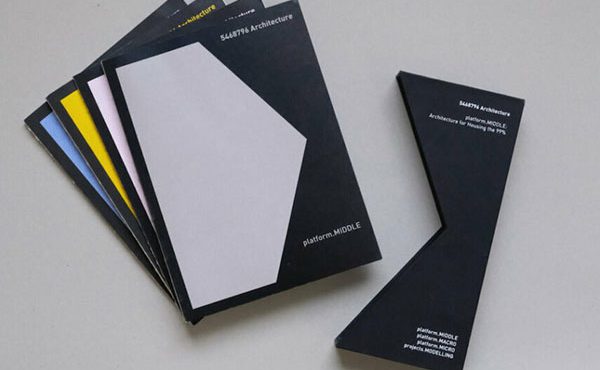A city’s arts form an ecosystem. It’s easy to focus on the big features – the trees, as it were – but the true health of the system lies in the understory, in the buzz of life at the ground level, in the shoots springing up and creatures hustling in the earth that supports the larger structures. A thriving ecosystem is continually growing, evolving, renewing at the base.
That base can be easy to overlook, but if its environment becomes inhospitable and it starts to decline, the system will lose its vitality, even if the presence of the large trees above continues on for a time. Toronto’s art ecosystem has been buffeted by some significant stresses in the past few years, and while there’s been plenty of attention to the challenges experienced by the larger, more visible parts, in this issue (#68) we dig into what is happening in that essential understory.
The big, splashy, relatively well-funded institutions that tend to dominate attention in Toronto – TIFF, Luminato, Nuit Blanche, the Toronto International Festival of Authors, Mirvish productions, the AGO and ROM, the opera, symphony, and ballet – are mostly about bringing outside arts to Toronto. It’s a valuable and important role, but a truly creative city needs to generate its own art as well.
And Toronto does so. Our city has a long and proud history of locally-grown creativity in many areas – visual arts, music, live performance (theatre, comedy, dance), movies and TV, and more. It’s largely a grassroots ecosystem, often growing in cracks and margins, always a bit fragile but at the same time adaptive and resilient.
In recent years, that ecosystem has been buffeted by even more shocks than usual. The pandemic that prevented audiences from gathering in person threatened its sense of community – both between artists themselves and between artists and audiences. While that restriction is thankfully past, the lingering effects continue to be felt, a kind of long Covid of the arts leaving many suffering even after the acute crisis has passed.
Meanwhile, the rapid rise of rents in the past decade and, along with it, the filling in and conversion of the kind of neglected spaces that provide venues for artistic creation have made it increasingly difficult for artists to find places to live, to create, and to show their work.
Yet Toronto’s artists are finding ways to persist, adapt, and even flourish. We explore how local artists are finding ways to overcome these challenges to create and show their work, and continue to generate that sense of community. But artists also need support – from audiences, exhibitors, venues – and we look at that too. At the grassroots level, our writers look at venues for film and performance, and the potential of land trusts to provide affordable spaces for artists. And at a high level, we talk to Mayor Olivia Chow about how the city can help support the arts.
Beyond the typical venues, in a healthy the city the arts are everywhere, and that’s true of this issue as well. This fall, the Bentway staged a remarkable happening, an extended line of dominoes that fell across 2.5 kilometres of the city, captured in in our front section by photographer Steven Evans. Elsewhere in the front section, Trent Weston evokes the vibrant annual Día de los Muertos celebration in Wychwood Barns, while Tatum Dooley shares her enthusiasm for Katharine Harvey’s gorgeous floral mosaic that brings life to Chester subway station.
Other pieces in our front section also capture the constant evolution of the city. Ian Darragh profiles Stephen Velasco’s 3D maps of upcoming developments. Sanaphay Rattanavong looks at the disturbing evolution of cars into vehicular megafauna. Emilie Adin casts an eye on the changes of fashion – even the extinction – of urbanist terms. Emily Wiens analyzes how street trees fit into our urban environment. Meanwhile, Colin Ellard takes the question in the other direction, asking how our cities fit with the way we humans have evolved.
Cities, like a forest, give a first impression of solidity and permanence – the buildings and streets concrete and imposing. But, like a forest, in fact they are full of movement, activity, and change. The arts are an essential part of that vibrancy, not only bringing life to the city, but contributing to that process of evolution and adaptation. Sometimes, like the dominoes, their contribution is ephemeral, happening once and then gone, but that flash remains in the memories of those who experienced it, and opens possibilities for the next event. Other times, the contribution is longer-term, like Chester station’s flowers, bringing the kind of colour, variety, and detail to the overwhelming city that Ellard says is vital to making it human. It’s a reminder that arts aren’t a frill, but essential to city life.
This issue is available now at the Spacing Store at 401 Richmond St. W., and soon at fine book and magazine stores, as well as arriving soon in subscribers’ mailboxes. Note that subscriber deliveries may be delayed if there is a postal strike.



